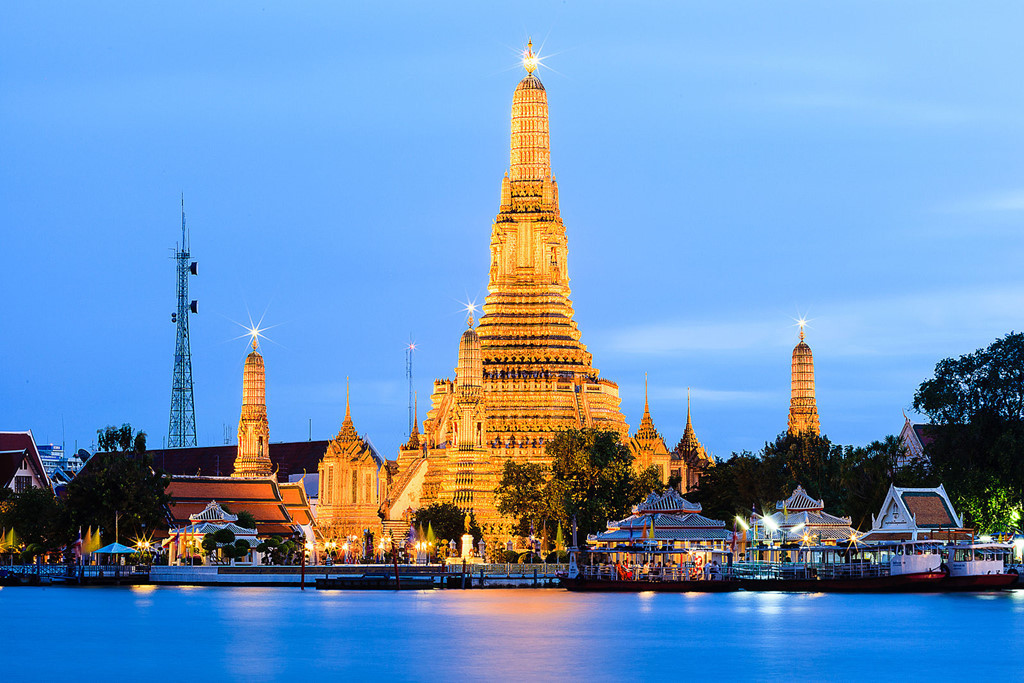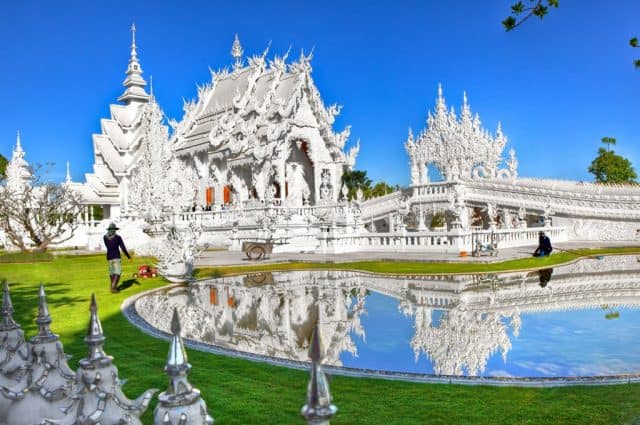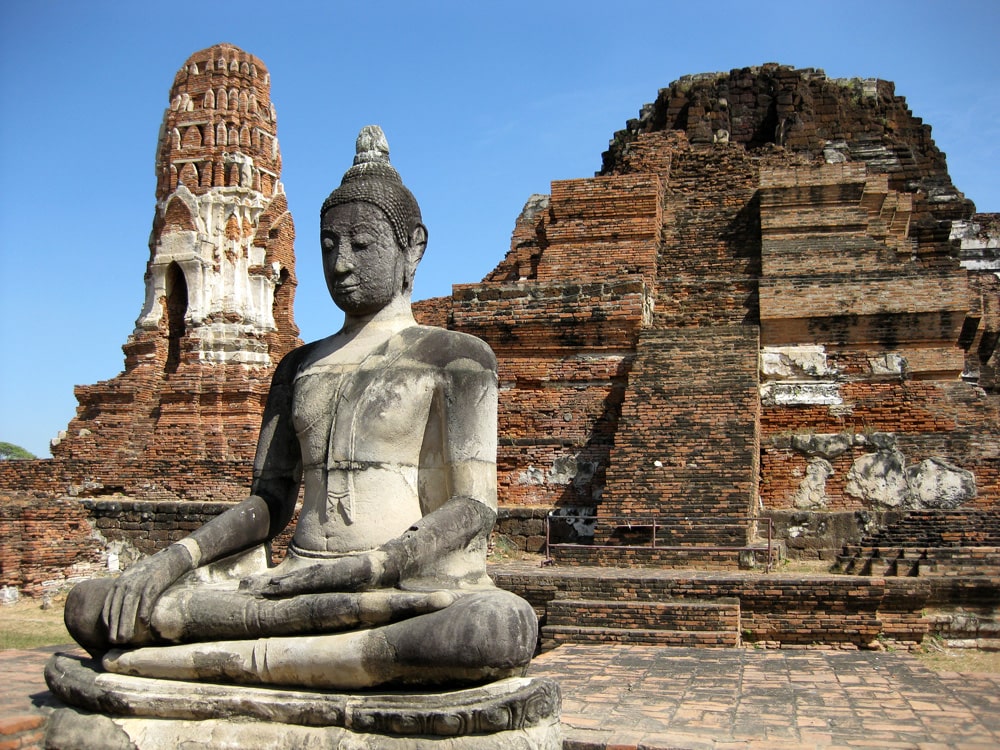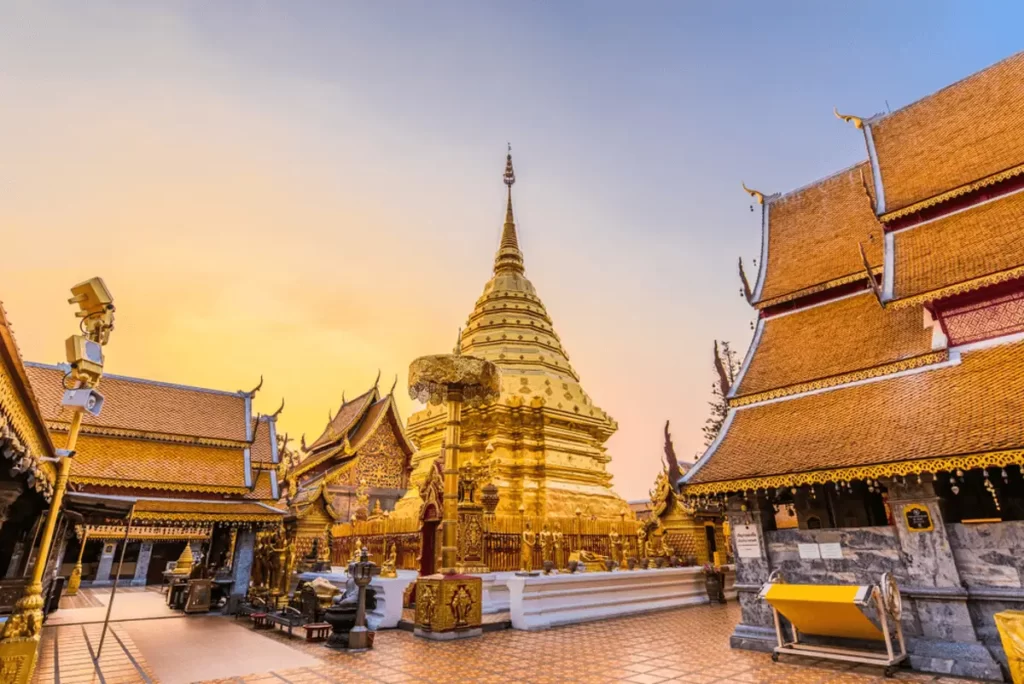Thailand is often praised as the “Land of a Thousand Temples” and is a familiar destination for those who love spiritual tourism. When you have the opportunity to visit this Southeast Asian country, you will surely be fascinated by the series of Buddhist temples, each echoing the stories of bygone dynasties, unique architecture and prosperity deep religious reverence.
From the shimmering spiers of Wat Phra Kaew in bustling Bangkok to the serene heights of Wat Phra That Doi Suthep overlooking Chiang Mai, each temple invites you to delve deeper into the spiritual heart of Thailand.
1. Wat Phra Kaew (Temple of the Emerald Buddha)
- Address: Na Phra Lan, Phra Nakorn (Inside the Royal Palace of Thailand)
- Opening hours: 8:30 a.m. – 1:30 a.m.
- Ticket price: 500 baht.
Wat Phra Kaew, commonly referred to as Temple of the Emerald Buddha, is one of Thailand’s most revered and iconic religious structures. Nestled within the confines of Bangkok’s Grand Palace, it stands as a testament to the profound spiritual significance and architectural prowess of Thai culture.
One primary reason it captivates tourists globally is the presence of the Emerald Buddha, a magnificent statue carved from a single block of jade, regarded as the most sacred Buddha image in Thailand. The statue’s rich history and the reverence with which the Thai people hold it resonate with visitors, offering a deep dive into Thai spirituality and culture.
As you tread the temple’s grounds, you’re immersed in a visual spectacle. Intricately designed murals, depicting scenes from the Ramakien (the Thai version of the Ramayana), adorn the walls, providing a tapestry of stories and historical narratives. Glistening golden stupas, ornate statues, and meticulously crafted sculptures accentuate the temple’s landscape, each holding a story of its own.
Furthermore, the architecture itself is a marvel. Wat Phra Kaew showcases classical Thai temple architecture with its multi-tiered roofs, elaborately decorated spires, and vibrant color palettes, primarily in green and orange hues.
While you explore, you can also experience the solemn rituals and ceremonies conducted by monks. These rituals, often accompanied by traditional Thai chants, provide a serene ambiance and offer an introspective moment for many.
Wat Phra Kaew is more than just a visual treat; it’s an experience. The temple’s serene atmosphere, combined with its rich historical narrative and unparalleled architectural splendor, offers you a holistic understanding of Thai heritage. As you meander through the temple grounds, you don’t just witness history; you feel it. It’s a journey that transcends mere sightseeing and delves deep into the spiritual and cultural ethos of Thailand.
2. Wat Pho (Temple of the Reclining Buddha)
- Address: No. 2 Sanamchai Road, Grand Palace Subdistrict.
- Opening hours: 8:30 a.m. – 6:30 p.m.
- Ticket price: 100 baht.
Wat Pho, officially titled Wat Phra Chetuphon Vimolmangklararm, stands as one of Bangkok’s oldest and most esteemed temples. Situated near Chao Phraya River, this historical monument is renowned for housing the impressive Reclining Buddha statue, a colossal figure spanning 46 meters in length and 15 meters in height. Adorned in gold leaf and with intricate mother-of-pearl inlays on its feet, this statue provides a striking representation of Buddha’s passage to Nirvana.
One of the most compelling reasons tourists are drawn to Wat Pho is its reputation as the birthplace of traditional Thai massage. Not only can you marvel at the temple’s rich history and intricate architecture, but you can also experience authentic Thai massage. This therapeutic technique, rooted in ancient practices, has been preserved and taught at Wat Pho for centuries. The temple grounds house a traditional medicine and massage school, making it a living testament to Thailand’s age-old therapeutic traditions.
As you navigate through the expansive temple complex, you’re introduced to a vast array of intricate designs and structures. There are more than a thousand Buddha images, each with its unique design and significance, making it one of the largest collections in Thailand. Additionally, intricately detailed murals, telling stories from Thai folklore and Buddhist scriptures, span the walls of the temple, providing both a visual and educational feast.
The temple complex’s layout, with its many courtyards, halls, pagodas, and gardens, mirrors the architectural grandeur of the Ayutthaya period. This splendid design, adorned with intricate carvings, statues, and colorful tiles, offers an aesthetic experience like no other. As you traverse its grounds, the ambiance offers a sense of tranquility, often heightened by the soft chants of monks and the gentle tinkle of bells.
3. Wat Arun (Temple of Dawn)
- Address: Th Arun Amarin.
- Opening hours: 8am – 5pm daily.
- Ticket price: 50 baht.
Wat Arun, colloquially known as Temple of Dawn, stands as a majestic silhouette on the banks of the Chao Phraya River in Bangkok. Its distinct prang (spire) and design, heavily influenced by the Khmer architectural style, make it distinguishable from other Thai temples and contribute significantly to Bangkok’s iconic skyline.
The temple’s name derives from the Hindu god Aruna, personified as the radiations of the rising sun. True to its name, Wat Arun is renowned for the ethereal aura it radiates during sunrise. The first light reflecting off the temple’s intricate mosaics of tiny pieces of colored glass and Chinese porcelain is nothing short of mesmerizing. This phenomenon has become symbolic of the temple, making dawn one of the most preferred times for tourists to visit.
One of the compelling experiences Wat Arun offers you is the chance to ascend the steep stairs of the central prang. As you climb, the expansive view of the Chao Phraya River and the Bangkok cityscape unfurls before you, culminating in a panoramic vista at the top that’s both breathtaking and memorable.
As you explore the temple grounds, you’ll encounter a series of meticulously detailed statues and carvings. The guardian figures, known as the Yaksha, stand tall at the entrance of the temple, serving as protectors of the sacred grounds. Their vibrant colors and intricate details provide a rich visual experience.
Beyond its architectural grandeur, Wat Arun is steeped in history. Its existence predates the establishment of Bangkok as the capital, and it has played a pivotal role in various historic ceremonies and Buddhist rituals over the centuries.
In navigating Wat Arun, you’re not just walking through a temple; you’re stepping into an emblem of Thai heritage. Its architectural nuances, combined with its historic significance, offer a profound insight into Thailand’s cultural and spiritual fabric. Whether you’re capturing the sunrise, marveling at its architectural intricacies, or simply soaking in the serene ambiance, Wat Arun ensures an experience that’s both enriching and awe-inspiring.
4. Wat Phra Singh (Temple of the Lion Buddha)
- Address: 2 Samlarn Rd, Phra Sing, Amphoe Mueang Chiang Mai, Chang Wat Chiang Mai 50280.
Wat Phra Singh, nestled in the heart of the historic city of Chiang Mai, stands as one of the most venerated temples in Northern Thailand. Established in the 14th century, this temple, with its glistening gold façade and intricate Lanna-style architecture, epitomizes the rich cultural heritage of the Lanna Kingdom.
The temple’s name, “Wat Phra Singh,” translates to “Temple of the Lion Buddha.” Central to the temple’s significance is the revered Phra Singh Buddha image, housed within the Viharn Lai Kham. This highly esteemed statue, adorned in gold and characterized by its serene expression, draws pilgrims and tourists alike, who come to offer their respects and seek blessings.
As you venture deeper into the temple complex, you’re treated to a visual feast of historical and architectural wonders. The main wihan, or prayer hall, stands out with its multi-tiered roof, adorned with ornate Naga bargeboards, offering a striking example of traditional Lanna craftsmanship. The walls of this hall showcase exquisite murals that depict scenes from daily life in early Chiang Mai, offering you a unique window into the region’s historical tapestry.
An equally captivating feature of Wat Phra Singh is Ho Trai, the temple’s library. Elevated on a base of stone to protect the sacred scriptures from floods and pests, its wooden façade boasts intricate carvings and designs, reflecting the artistry of bygone eras.
The temple’s grounds provide a sanctuary of tranquility amidst Chiang Mai’s bustling city life. As you stroll through the manicured gardens, the soft chants of monks and the gentle fragrance of incense offer a meditative escape, allowing moments of reflection and serenity. Wat Phra Singh is more than just an architectural marvel; it’s a testament to the region’s spiritual and cultural legacy.
5. Wat Rong Khun (White Temple)
- Address: Pa O Don Chai, Mueang Chiang Rai, Chiang Rai 57000
Wat Rong Khun, often referred to as the “White Temple,” is an unconventional and contemporary religious structure located in Chiang Rai, Northern Thailand. Unlike the traditional gold-adorned temples prevalent in Thailand, Wat Rong Khun is distinctively white, with embellishments of mirrored glass. This architectural marvel is the brainchild of the renowned Thai visual artist and painter, Chalermchai Kositpipat, who began the project in 1997.
At first glance, the temple’s pristine white façade, representative of the purity of Buddha, is a stark contrast to the often colorful and gilded temples you might encounter throughout Thailand. The mirrored glass, embedded in the structure’s plaster, signifies Buddha’s wisdom shining out across the Earth.
One of the temple’s most talked-about features is the bridge leading to the main building. As you approach the temple, you’re met with an eerie sea of outreached hands, symbolizing human desire and suffering. This pathway, known as the “Bridge of the Cycle of Rebirth,” provides a vivid representation of escaping earthly desires and moving towards enlightenment and spiritual transcendence.
Inside, the temple continues to surprise. In lieu of traditional murals depicting scenes from Buddhist scriptures, you encounter contemporary art with depictions of modern idols and events, driving home the temple’s theme of the battle between good and evil in today’s context.
The temple grounds also house other structures, including the golden building representing the body, while the main temple represents the mind. This juxtaposition of colors and themes serves as a metaphor for worldly desires versus spiritual enlightenment.
Wat Rong Khun’s uniqueness lies not just in its aesthetic appeal but also in its profound symbolism. For you, the visitor, it offers a distinct blend of art, culture, and spirituality, making it an immersive experience that’s both contemplative and visually enthralling. Its blend of traditional motifs with modern interpretations offers you a fresh perspective on Thai culture and spirituality, making it an unforgettable stop on any journey through Northern Thailand.
6. Wat Suthat Temple
- Address: Bamrung Muang Road, opposite Bangkok City Hall.
- Opening hours: 8:30 a.m. – 9:00 p.m.
- Ticket price: 20 baht.
Wat Suthat, ensconced in the historic center of Bangkok, is one of the city’s oldest and most significant Buddhist temples. Commissioned by King Rama I in the late 18th century, it stands as a testament to the timeless grandeur of Thai religious architecture and artistry.
Central to Wat Suthat’s allure is Phra Sri Sakayamuni, a monumental Buddha image originally from Sukhothai. Revered for its sheer size and historical significance, this statue serves as a focal point for devotees and tourists alike. As you gaze upon its serene countenance, you’re not only witnessing religious reverence but also a connection to Thailand’s ancient past.
The main ordination hall, or ubosot, is a masterpiece of architectural symmetry. As you step inside, you’re enveloped by rows of intricately carved teakwood door panels and window shutters, each narrating tales from the Jataka, stories about Buddha’s previous lives. These tales, etched in gold and black lacquer, offer you a glimpse into the rich tapestry of Buddhist lore.
Adjacent to the temple, the Giant Swing, or Sao Ching Cha, another iconic Bangkok landmark, stands tall. Historically used in religious ceremonies where participants would swing to grab a bag of coins, it adds to the area’s spiritual ambiance.
One of the subtle yet profound features of Wat Suthat that might captivate you is its collection of 156 Buddha images seated around the cloister. Each image, with its unique pose and expression, evokes contemplation and serenity.
Beyond the striking visuals, the rhythmic chants of monks during evening prayers offer a sonic escape from Bangkok’s urban cacophony. As you immerse yourself in this soundscape, the temple’s tranquility provides a soothing counterpoint to the bustling city life outside.
7. Wat Benchamabophit (Marble Temple)
- Address: 5 Dusit, Dusit District, Bangkok 10300, Thailand
- Opening hours: 8:30 a.m. – 5:00 p.m.
- Ticket price: Free
Wat Benchamabophit, commonly known as the Marble Temple, is one of Bangkok’s architectural and spiritual jewels. Constructed at the close of the 19th century during the reign of King Rama V, this temple uniquely marries traditional Thai temple architecture with European design elements, embodying a period when Thailand was increasingly opening up to Western influences.
What sets Wat Benchamabophit apart, as its moniker suggests, is its extensive use of Italian Carrara marble. From its courtyard to the ornate pillars and the main temple’s façade, the gleaming white marble lends the temple an air of elegance and tranquility.
As you walk through the main entrance, the first thing to catch your eye would likely be the intricate detailing of the gables, juxtaposed with stained glass windows — a fusion that’s both unusual and captivating in a Thai temple. The central ubosot, or ordination hall, houses a sublime Sukhothai-style Buddha statue known as Phra Buddhajinaraja, cast in 1920 after the original located in Phitsanulok.
Encircling the ordination hall, the cloister contains a remarkable collection of 52 Buddha images, representing various styles and periods from Thai history. As you meander, you gain insight into the evolution of Buddha iconography in Thailand, with each statue narrating a different chapter from the nation’s rich artistic legacy.
The temple’s grounds, meticulously landscaped with lotus ponds and bridges, offer a serene backdrop. Early mornings see monks in their saffron robes collecting alms, providing you with a snapshot of monastic life and age-old traditions.
Beyond its visual splendor, Wat Benchamabophit also serves as an active monastery. The daily rituals, the fragrance of incense, and the soft murmurs of prayers create an ambiance that invites introspection and reverence.
In immersing yourself in Wat Benchamabophit, you’re engaging with a site that’s more than just a tourist attraction. It’s an embodiment of Thailand’s cross-cultural exchanges, its deep-rooted spirituality, and its commitment to preserving heritage amidst modernity. The temple, in its silent majesty, promises you not only a visual treat but also an opportunity to connect with a facet of Thai culture that’s both historical and timeless.
8. Wat Mahathat Temple
- Address: Phra That Road, Old City.
- Opening hours: 9am – 5pm.
- Ticket price: about 30 baht.
Wat Mahathat, often identified among the most evocative historical sites in Thailand, is situated in the ancient city of Ayutthaya, a UNESCO World Heritage site. Founded during the 14th century, this temple complex once stood as a pivotal center of Buddhist learning and was an emblem of the Ayutthaya Kingdom’s religious significance.
The ruins of Wat Mahathat bear silent testimony to the grandeur and complexity of Ayutthaya’s architectural prowess and the city’s historical relevance. As you wander through the remains, you are immediately confronted with an array of chedis (stupas), prangs (towers), and rows of headless Buddha statues – remnants of past invasions. These structures, though affected by the passage of time and human conflict, evoke a potent sense of nostalgia and reverence for a bygone era.
Perhaps the most photographed and iconic feature of Wat Mahathat is the stone Buddha head entwined within the roots of a Bodhi tree. This surreal sight, with the serene visage of Buddha seemingly cradled and embraced by nature, offers you a poignant representation of the inexorable march of time and the interplay between human civilization and nature.
While the architectural remnants and Buddha statues provide visual insights into the region’s past, the very soil of Wat Mahathat seems steeped in history. As you tread softly, you are treading on the same grounds where monks once meditated, where scholars debated religious texts, and where kings sought spiritual solace.
Beyond the historical and architectural allure, Wat Mahathat provides an ambiance conducive to contemplation. The whispers of the wind, the gentle rustling of leaves, and the distant sounds of the surrounding city fuse to create an atmosphere that is both peaceful and introspective.
For anyone seeking to immerse themselves in Thailand’s rich tapestry of history, spirituality, and art, Wat Mahathat offers a unique experience. Here, you are not merely an observer but an active participant in a narrative that spans centuries, engaging with the ebb and flow of empires, the spiritual aspirations of a civilization, and the enduring power of nature over man-made marvels.
9. Wat Phrathat Doi Suthep Temple
- Address: 9 Mueang Chiang Mai District, Chiang Mai 50200, Thailand.
- Opening hours: 6:30 a.m. – 6:30 p.m.
- Ticket price: 40 baht.
Wat Phrathat Doi Suthep is one of Northern Thailand’s most iconic and revered temples, perched high atop the Doi Suthep Mountain overlooking the city of Chiang Mai. Founded in the 14th century, this sacred site has not only religious but also cultural and historical significance, serving as a beacon of Lanna heritage.
The legend surrounding its foundation is steeped in mystique. As the tale goes, a monk named Sumanathera had a dream indicating the presence of a significant relic. Upon excavation, he discovered a bone, believed to be the Buddha’s shoulder bone, which showcased miraculous characteristics. The bone was mounted on a sacred white elephant, which then climbed Doi Suthep and, upon reaching a particular spot, trumpeted three times before passing away. This was interpreted as an omen, leading to the construction of Wat Phra That Doi Suthep at that very location.
Ascending towards the temple is, in itself, a spiritual journey. As you climb the 306-step Naga serpent staircase, you are not only engaging in a physical endeavor but also in a symbolic ascent towards enlightenment. Each step brings you closer to the shimmering golden chedi, the temple’s centerpiece, which houses the sacred relic. This chedi, bathed in sunlight during the day and illuminated at night, resonates with the devout prayers and chants of monks and pilgrims, creating a serene and spiritually charged ambiance.
Surrounding the central chedi, you will encounter a panorama of intricately crafted statues, pagodas and bells. The murals adorning the temple walls narrate stories from Buddhist scriptures and the history of the temple itself, offering you a vivid insight into Thai religious and cultural narratives.
One of the unique aspects of Wat Phra That Doi Suthep is its vantage point. From its terraces, you are graced with a breathtaking view of Chiang Mai and the surrounding valley. This juxtaposition of spiritual serenity with natural beauty ensures that your visit transcends mere sightseeing.
Apart from its architectural and religious allure, the temple often hosts ceremonies, rituals, and festivals, providing you with an opportunity to witness and participate in traditional Lanna practices.
10. Wat Phumin Temple
- Address: Phakong, Nai Wiang, Mueang Nan District, Nan Province 55000
Wat Phumin, nestled in the heart of Nan province in Northern Thailand, stands as a unique testament to the region’s rich tapestry of cultural and artistic heritage. Distinguished by its architecture and invaluable murals, this temple has, over the years, become an emblem of the province’s distinct identity in the broader Thai context.
Built in the late 16th century, Wat Phumin deviates from the typical temple layout. Its most striking feature is its cruciform-shaped Ubosot (ordination hall), which integrates four chapels into a singular structure. As you step inside, you are immediately greeted by the sight of four massive, seated Buddha images, their backs against each other, facing the four cardinal directions. This configuration is a rare architectural element, making the temple uniquely captivating for both architectural enthusiasts and spiritual seekers.
However, the true allure of Wat Phumin lies in its murals, which are among Thailand’s most exquisite and well-preserved. These murals, predominantly found on the interior walls, narrate tales from the Jataka (stories of Buddha’s previous lives) and the local legends of the Tai Lue people, providing you with a visual journey into both Buddhist teachings and regional folklore.
One particular mural, depicting a man whispering to the ear of a woman, has become iconic and is often referred to as the “Whispering Mural”. This image, beyond its artistic value, provides an intriguing glimpse into the social customs and daily life of the Tai Lue community during that era.
As you navigate through Wat Phumin, you’ll also notice the intricate wood carvings and the richly adorned Naga (serpent) motifs that embellish the temple’s staircases, a nod to the region’s artisanal traditions.
The temple serves as more than just a religious site. It is a living museum, offering you a deep dive into the cultural, historical, and artistic epochs of the Nan province. The ambiance within the temple, characterized by the muted hues of the murals, the soft gleam of the golden Buddhas, and the hushed reverence of visitors, invites introspection and an appreciation for the confluence of art and spirituality.
In Thailand, splendid Buddhist temples are more than just architectural structures; they are the embodiment of the nation’s soul. These temples, despite their deep historical roots, continue to shape and inspire contemporary Thai identity.















